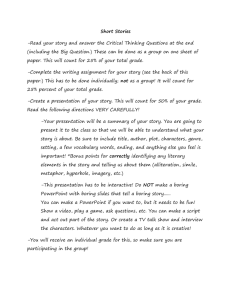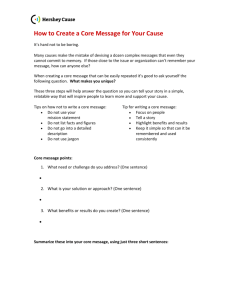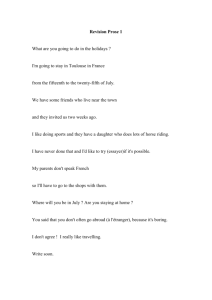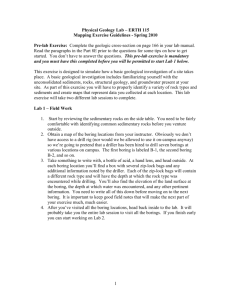1.0 Setting Up And Using Boring Tools
advertisement
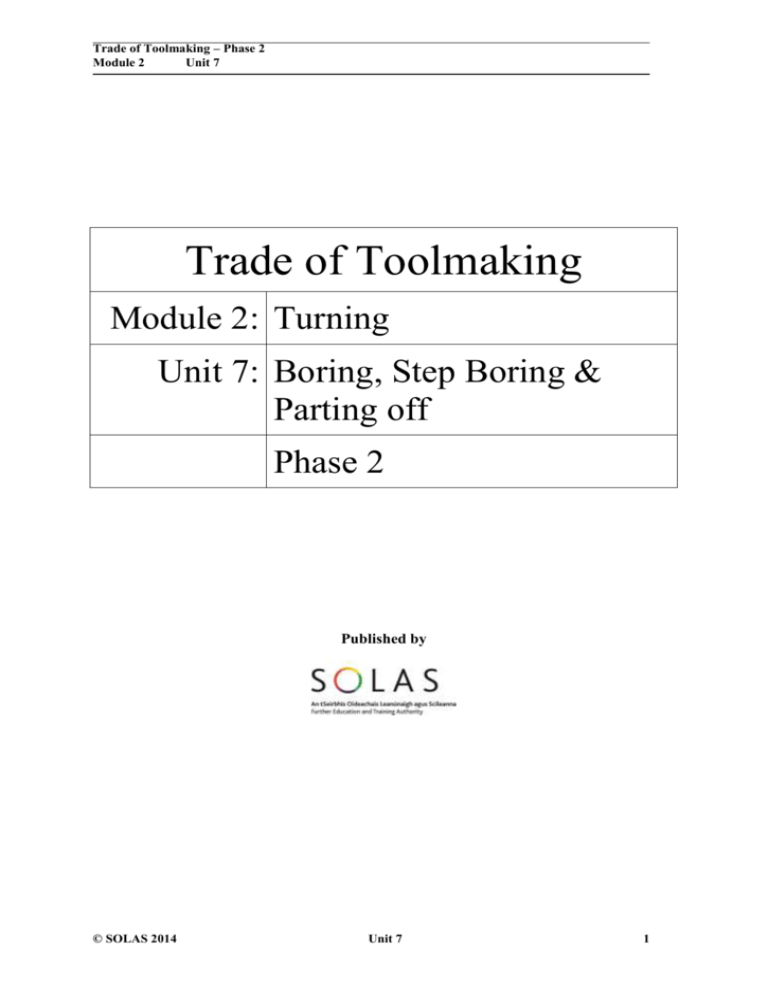
Trade of Toolmaking – Phase 2 Module 2 Unit 7 Trade of Toolmaking Module 2: Turning Unit 7: Boring, Step Boring & Parting off Phase 2 Published by © SOLAS 2014 Unit 7 1 Trade of Toolmaking – Phase 2 Module 2 Unit 7 Table of Contents Document Release History .................................................................................................. 3 Unit Objective....................................................................................................................... 4 Introduction .......................................................................................................................... 4 1.0 Setting Up And Using Boring Tools ....................................................................... 5 1.1 Boring speeds: calculation of boring speeds and feed ........................................... 5 1.2 Tools Set Up/Overhang ......................................................................................... 5 1.3 Work Chatter/Quality Of Surface Finish ............................................................... 5 1.4 Parallelogram Of Forces And The Resultant Of Two Forces ................................ 5 1.5 Calculation Of Speeds And Feeds For Parting Off................................................ 5 1.6 Planning Job Sequences And Use Of Measuring Tools ........................................ 6 1.7 Transposition Of Formula; Pythagoras Theorem .................................................. 6 2.0 Boring Mild Steel To Specified Dimensions .......................................................... 7 2.1 Conventional Representations Of Bore Diameters And Tolerances ..................... 7 2.2 Dimensioning of components to BS 8888 ............................................................. 7 2.3 Use and care of measuring instruments ................................................................. 7 2.4 Use of telescopic gauges to measure bore diameters ............................................. 7 2.5 Machine operation and use of boring bar .............................................................. 7 3.0 Step Boring Mild Steel To Specified Dimensions .................................................. 8 3.1 Step Boring And Use Of Depth Stops ................................................................... 8 3.2 Use Of Depth Micrometers To Measure Bore Diameters ..................................... 8 Summary ............................................................................................................................... 9 Suggested Exercises ........................................................................................................... 10 Questions............................................................................................................................. 11 Answers ............................................................................................................................... 12 Recommended Additional Resources ............................................................................... 13 Reference Books .............................................................................................................. 13 © SOLAS 2014 Unit 7 2 Trade of Toolmaking – Phase 2 Module 2 Unit 7 Document Release History Date Version Comments 25/09/2014 2.0 SOLAS transfer © SOLAS 2014 Unit 7 3 Trade of Toolmaking – Phase 2 Module 2 Unit 7 Unit Objective On completion of this unit you will be able to set-up and perform internal step boring to the correct spindle speeds and feeds. Introduction Module two of this course covers turning. This is the seventh unit in module two and introduces the techniques associated with setting up and performing internal step boring to the correct spindle speeds and feeds. The boring bar can also be used to create internal bores and stepped bores, recesses, radii and for screw threading. The vernier calliper is used to measure internal diameters, but for more precise measurements the internal micrometer or telescopic gauges are used. For measuring internal step depths a vernier callipers is used, but for more precise measurements the Module 2 Turning Unit 1 Machine Controls Unit 2 Facing, Parallel & Step turning Unit 6 Recessing & Radiusing Unit 7 Boring & Parting Off Unit 3 Drilling, Reaming & Tapping Unit 8 Concentric Turning (4 Jaw) Unit 4 Taper Turning & Knurling Unit 5 Tool Grinding & Forming Unit 9 Screwcutting Unit 10 Turning & Assembling depth micrometer is used. By the end of this unit you will be able to: Correctly set up and use boring tools. Bore through mild steel to supplied dimensions. Step bore mild steel to specified dimensions. © SOLAS 2014 Unit 7 4 Trade of Toolmaking – Phase 2 Module 2 Unit 7 1.0 Setting Up And Using Boring Tools Key Learning Points Boring speeds: calculation of boring speeds and feed. Tools set up/overhang. Work chatter/quality of surface finish. Parallelogram of forces and the resultant of two forces. Calculation of speeds and feeds for parting off. Planning job sequences and use of measuring tools. Transposition of formula, Pythagoras theorem. 1.1 Boring speeds: calculation of boring speeds and feed When using a boring bar to machine internal recesses or undercuts, the speed of the chuck should be reduced to half that of ordinary turning speeds. It is important to use coolant for all boring operations. Cutting speed is expressed in meters per minute. This refers to the distance covered by the tool across the material when machining. A chart is available listing various materials and their corresponding cutting speeds. The revolutions per minute (RPM) is calculated by using the RPM formula: RPM = S x 1000 лxD Ref: Black, Bruce J 2004, Workshop processes, practices and materials, 3rd edn, Elsevier Science & Technology, chapter 9, Turning, p. 153. ISBN-13: 9780750660730 1.2 Tools Set Up/Overhang The overhang is the distance from the tip of the tool to the tool post. This distance should be just long enough to perform the boring operation, as too much of an overhang will result in chatter marks on the workpiece. 1.3 Work Chatter/Quality Of Surface Finish As explained above, chatter marks are produced by having too much of an overhang, which will result in a poor surface finish on the surface of the workpiece. 1.4 Parallelogram Of Forces And The Resultant Of Two Forces When machining on a lathe, three forces act on the tool, (i) the vertical or tangential force, (ii) the feed force and (iii) and radial force that tends to push the tool away from the workpiece. If the vertical and feed forces are known, they can be drawn to scale and lines drawn parallel to create a parallelogram. The diagonal line can be measured to determine the resultant or the radial force. 1.5 Calculation Of Speeds And Feeds For Parting Off When using a boring bar to machine an internal recess or undercut, the speed of the chuck should be half that for ordinary turning speed. It is important to use coolant for all boring operations. © SOLAS 2014 Unit 7 5 Trade of Toolmaking – Phase 2 Module 2 Unit 7 1.6 Planning Job Sequences And Use Of Measuring Tools Job planning is important prior to starting any task. The drawing should first be studied and understood. Precision measuring equipment is used such as the; Surface Plate, Try Square, the Protractor, Dial Gauge, Rule, Micrometer and the Vernier Calipers. Care should be taken when using measuring equipment. Treat measuring equipment as delicate precision instruments, as they can be easily damaged and should be stored in a secure place. Ref: Black, Bruce J 2004, Workshop processes, practices and materials, 3rd edn, Elsevier Science & Technology, chapter 3, Marking out, chapter 6, Measuring equipment. ISBN-13: 9780750660730 1.7 Transposition Of Formula; Pythagoras Theorem Trigonometry means the measurement of triangles. The Pythagoras Theorem can be used to find the length of one side or a right angled triangle if the lengths of the other two sides are known. The theorem states that for a right angled triangle the square on the hypotenuse (longest side) is equal to the sum of the squares on the other two sides. Ref: Bird, John 2005, Basic engineering mathematics, 4th edn, Elsevier Science & Technology, chapter 19, Introduction to trigonometry, p. 142. ISBN-13: 9780750665759 © SOLAS 2014 Unit 7 6 Trade of Toolmaking – Phase 2 Module 2 Unit 7 2.0 Boring Mild Steel To Specified Dimensions Key Learning Points Conventional representations of bore diameters and tolerances. Dimensioning of components to BS 8888. Use and care of measuring instruments. Use of telescopic gauges to measure bore diameters. Machine operation and use of boring bar. 2.1 Conventional Tolerances Representations Of Bore Diameters And Orthographic projection is used in engineering drawing to represent component parts. The internal bore is dimensioned to BS 8888, with a diameter sign and the required tolerance band. 2.2 Dimensioning of components to BS 8888 The drawing should contain adequate information such as, dimensions, tolerances surface finish, etc., to allow the part to be manufactured. This information is also used to inspect the finished part. BS 8888 covers all aspects of dimensioning. Ref: Simmons, Colin H & Maguire, Dennis E 2004, Manual of engineering drawing, 2nd edn, Elsevier Science & Technology, chapter 14, Dimensioning principles, p. 100. ISBN-13: 9780750651202 2.3 Use and care of measuring instruments Care should be taken when using measuring equipment, as they are delicate and can be easily damaged. Measuring instruments should be stored in a secure place. 2.4 Use of telescopic gauges to measure bore diameters Telescopic gauges or internal micrometers can be used to check the internal diameters. When using the telescopic gauge, allow the plunger to fully expand in the hole, tighten the locking screw and rock it slightly across the diameter until a suitable ‘feel’ is obtained. Firmly lock the plunger, remove it from the hole and measure with a micrometer. 2.5 Machine operation and use of boring bar The workpiece needs to be drilled out to within a couple of millimetres of the required bore diameter. The boring bar should be set-up as explained above. The automatic traverse of the saddle generates the internal bore. If a tapered hole is required, the compound slide is indexed to the required angle and the boring bar is hand fed across the workpiece. Ref: Black, Bruce J 2004, Workshop processes, practices and materials, 3rd edn, Elsevier Science & Technology, chapter 9, Turning Boring, p. 153. ISBN-13: 9780750660730 © SOLAS 2014 Unit 7 7 Trade of Toolmaking – Phase 2 Module 2 Unit 7 3.0 Step Boring Mild Steel To Specified Dimensions Key Learning Points Use of depth stops. Use of depth micrometers to measure bore diameters. 3.1 Step Boring And Use Of Depth Stops The workpiece is drilled out as explained above. The smallest bore is normally machined first. In order to ensure the correct depth for the step, the tool can be touched off the front face of the workpiece and the dial in the carriage used to measure the distance moved by the tool when boring. A vernier calipers should be used to measure the diameter and the depth. If a more accurate measurement is required, then a telescopic gauge can be used to measure the diameter and a depth micrometer can be used for the depth. Use of depth stops: An adjustable stop, which is positioned under the front slideway, can be used to stop the carriage when it reaches a particular position. This is a helpful device when multiple cuts are being machined in a deep bore. 3.2 Use Of Depth Micrometers To Measure Bore Diameters The depth micrometer is used for measuring depths of holes, slots and for measuring then depths of bores in a workpiece. Ref: Black, Bruce J 2004, Workshop processes, practices and materials, 3rd edn, Elsevier Science & Technology, chapter 6, Measuring equipment, p. 105. ISBN-13: 9780750660730 © SOLAS 2014 Unit 7 8 Trade of Toolmaking – Phase 2 Module 2 Unit 7 Summary Setting up and using boring tools: The boring bar is used when holes need to be machined to a precise dimension. The boring bars are available with HSS cutting tips and can be double ended, one end for a turning tool and the other to hold an undercuting tool or a screw cutting tool. Boring bars are also available with tungsten carbide tips. Before starting the lathe make sure that the boring bar is free from interference in the pre-drilled hole. Keep the overhang of the tool to a minimum, in order to reduce chatter marks. Cutting speed is expressed in feet per minute or meters per minute. This refers to the distance covered by the tool across the material when machining. A chart is available listing various materials and their corresponding cutting speeds. The revolutions per minute (RPM) is calculated by using the RPM formula. When using boring bars to machine internal recesses or undercuts, the speed of the chuck should be half that for ordinary turning speed. It is important to use coolant for all boring operations. Boring mild steel to specified dimensions: The workpiece needs to be drilled out to within a couple of millimetres of the required bore diameter. The boring bar should be set-up as explained above. The automatic traverse of the saddle generates the internal bore. If a tapered hole is required, the compound slide is indexed to the required angle and the boring bar is hand fed across the workpiece. Telescopic gauges or internal micrometers can be used to check the internal diameters. When using the telescopic gauge, allow the plunger to fully expand in the hole, tighten the locking screw and rock it slightly across the diameter until a suitable ‘feel’ is obtained. Firmly lock the plunger, remove it from the hole and measure with a micrometer. Step boring mild steel to specified dimensions: The workpiece is drilled out as explained above. The smallest bore is normally machined first. In order to ensure the correct depth for the step, the tool can be touched off the front face of the workpiece and the dial in the carriage used to measure the distance moved by the tool when boring. A vernier calipers should be used to measure the diameter and the depth. If a more accurate measurement is required, then a telescopic gauge can be used to measure the diameter and a depth micrometer can be used for the depth. For recessing, the tool can be positioned as explained above. The tool is fed in by hand using the cross slide, where the dial can be set to zero. This can be used as a guide to calculate the depth. It is important to withdraw the tool if there is a build up of swarf and to check the diameter of the machined feature. © SOLAS 2014 Unit 7 9 Trade of Toolmaking – Phase 2 Module 2 Unit 7 Suggested Exercises 1. 2. 3. 4. 5. Bore a mild steel workpiece to a diameter of 30mm, using the RPM formula to calculate the spindle speed. Use a telescopic gauge and micrometer to measure the bore. List the various types of boring tools available. How can chatter marks be prevented when boring a workpiece? Machine a Ø30mm bore to 20mm deep and use a depth micrometer to measure the depth. © SOLAS 2014 Unit 7 10 Trade of Toolmaking – Phase 2 Module 2 Unit 7 Questions 1. 2. 3. 4. 5. When setting up a boring bar, explain the term ‘overhang’. Why is important to keep the overhang to a minimum. What spindle speed is used when using a boring bar? Explain how a telescopic gauge is used to measure an internal bore. Explain briefly how an internal bore is machined in a workpiece. © SOLAS 2014 Unit 7 11 Trade of Toolmaking – Phase 2 Module 2 Unit 7 Answers 1. 2. 3. 4. 5. The overhang is the distance from the tip of the tool to the tool post. Too much of an overhang will result in chatter marks on the workpiece, which are caused by vibration of the bar. The speed of the chuck should be half that for ordinary turning speed. It is important to use coolant for all boring operations. When using the telescopic gauge, allow the plunger to fully expand in the hole, tighten the locking screw and rock it slightly across the diameter until a suitable ‘feel’ is obtained. Firmly lock the plunger, remove it from the hole and measure with a micrometer. The workpiece should be drilled out to within a couple of millimetres of the required bore diameter. The boring bar should be set-up on centre and the automatic feed can be used to machine the internal bore. The bore will need to be measured after each machining run, using vernier callipers, telescopic gauge or internal micrometer. © SOLAS 2014 Unit 7 12 Trade of Toolmaking – Phase 2 Module 2 Unit 7 Recommended Additional Resources Reference Books Black, Bruce J 2004, Workshop processes, practices and materials, 3rd edn, Elsevier Science & Technology. ISBN-13: 9780750660730 Simmons, Colin H & Maguire, Dennis E 2004, Manual of engineering drawing, 2nd edn, Elsevier Science & Technology. ISBN-13: 9780750651202 Bird, John 2005, Basic engineering mathematics, 4th edn, Elsevier Science & Technology. ISBN-13: 9780750665759 © SOLAS 2014 Unit 7 13
